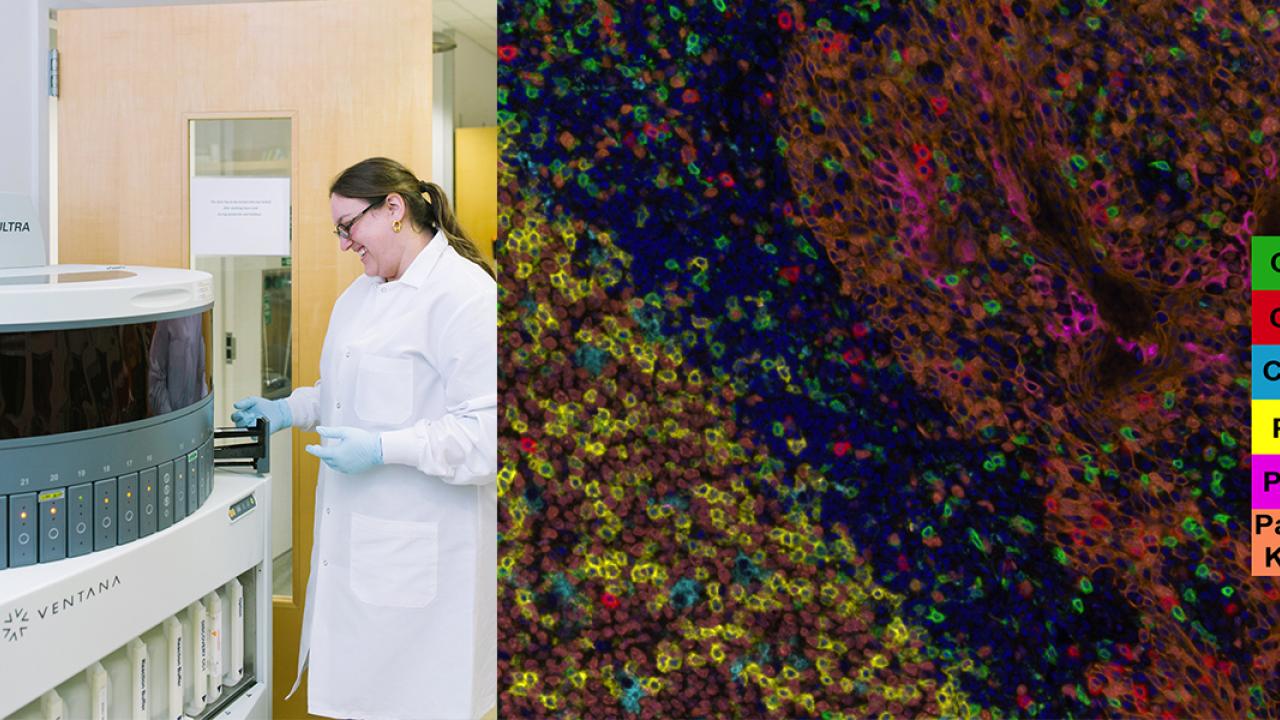
The goal of the Biorepository and Tissue Biomarker Technology Shared Resource (BTBMT) is to provide the infrastructure to support the life cycle and QA/QC of high quality biospecimens for cancer research. The multifaceted life cycle includes patient consenting, biospecimen acquisition, processing, storage, and distribution. The Biorepository also serves as the biospecimen core for the UCSF Biospecimen Resources (BIOS) Program that supports the research components of UCSF Precision Medicine, including Precision Cancer Medicine.
 "Our program facilitates UCSF's goal of precision medicine by increasing the number, quality, and value of biospecimens and data available to UCSF researchers."
"Our program facilitates UCSF's goal of precision medicine by increasing the number, quality, and value of biospecimens and data available to UCSF researchers."Read our Q&A with faculty director Scott VandenBerg, MD, PhD below.
What is the purpose of your core?
In short, we provide the infrastructure around human biospecimens for research, with a key emphasis on cancer.
Our Biorepository facility handles the collection, processing, and distribution of human biospecimens on campus. A key part of this process is our comprehensive patient consent, whereby any UCSF Health patient can sign up to donate their “minimal risk” biospecimens, including blood urine, stool, saliva/buccal swabs, and remnant tissue, obtained during the course of a diagnostic or therapeutic procedure. Once collected using specific protocols to optimize tissue quality according to organ site and disease process, these annotated biospecimens are then processed and stored for future scientific analysis.
Our Tissue Biomarker Technology facility, located at Mount Zion, provides processing and state-of-the-art tissue biomarker histologic detection and image analyses for both human and mouse tissue biospecimens.
Whom does your core serve?
Although our core is cancer-centric, we aim to serve the whole UCSF research enterprise.
Our acquisition team currently manages tissue collection and processing for eight surgical groups on campus: breast, gastrointestinal, liver, pancreas, genitourinary, head & neck, gynecologic oncology, and adult and pediatric sarcoma/solid tumors, in addition to transplant (liver and kidney), plastic, and cardiovascular surgery.
Our main facility is located at Mount Zion, but we have satellite facilities at Mission Bay and Parnassus to optimize acquisition and perform any necessary initial processing, including viable cells, on site. Location is not an impediment, as any of the biospecimens can then be sent to any location by courier.
Do you offer services to external (non-UCSF) users?
We do provide biomarker services to external customers, but all projects involving human tissue samples must involve a UCSF investigator.
What special technology or equipment does your core use that is invaluable to UCSF researchers?
Our Ventana Discovery Ultra, included in our Tissue Biomarker Technology services, offers complex biomarker multiplexed detection on whole slides. Our facility is one of the few labs that offers multiplexing not only for immunofluorescence but also with translucent chromogenic dyes in combination with whole slide scanning and object-based image analysis.
Another capability that we just established: automated computer-assisted tissue microarray construction.
What high profile projects and collaborations has the BTBMT core contributed to?
We have developed multiple 7-biomarker multiplex panels for profiling the immune infiltrates using Opal reagent kits (Perkin Elmer) on the fully automated Ventana Discovery Ultra platform, followed by imaging with a Vectra® 3.0 automated imaging system, and analysis with inForm® software (Perkin Elmer). This multiplex fluorescence analytical platform was used to characterize the immune infiltrates in tumor samples as a complement to immune gene expression signatures to better determine the predictors of response to the checkpoint inhibitor pembrolizumab in the neoadjuvant I-SPY 2 TRIAL. These studies in the Breast Oncology Program were led by Michael Campbell, PhD.
How will your services be affected by the opening of the Precision Cancer Medicine Building (PCMB) at Mission Bay?
Our program will have a laboratory in the new PCMB. It’s strategically located next to imaging and cytopathology to allow us to acquire research specimens, especially focusing on fine-needle aspirates and any other image-guided biopsies.
 We already have a lab in place at the Gateway Medical Building at Mission Bay, which services all of the surgical suites. Our lab in the new PCMB will service biospecimen acquisition in that facility.
We already have a lab in place at the Gateway Medical Building at Mission Bay, which services all of the surgical suites. Our lab in the new PCMB will service biospecimen acquisition in that facility.
How does your core support precision medicine efforts at UCSF?
Our program facilitates UCSF’s goal of precision medicine by increasing the number, quality, and value of biospecimens and data available to UCSF researchers.
Anything else you’d like the cancer community to know about the BTBMT?
The more that our program reaches across the entire campus, the bigger the benefit to the Cancer Center. The UCSF BIOS program excels at making synergies, making sure that all biospecimens are optimally used across campus. For instance, an investigator might come to us for DNA purification using buffy coat, not anticipating that the plasma can be used by another group for a different study.
There’s a lot of coordination that our services can provide. Because we are the independent brokers across the UCSF system, we have a good grasp of what the research needs are.